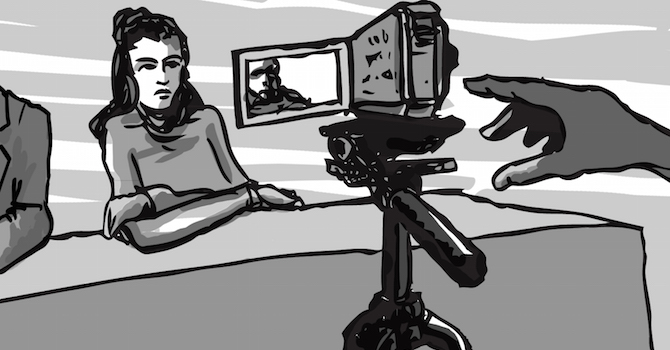Ethical Wednesdays: When Media is Created by the Perpetrators of the Abuse
Editor’s Note: This is the third post in a series on WITNESS’s Ethical Guidelines for Using Eyewitness Videos in Human Rights Documentation and Advocacy. Check back each Wednesday in the coming weeks for a new post on human rights video and ethics. For additional posts from the series, click here.
Imagine the following scenario. You are a human rights activist, and a cellphone video has been uploaded anonymously to a liveleak website showing prison guards forcing inmates to strip naked and perform dehumanizing acts. You are able to confirm with a prison employee that the footage is authentic. You write a press release calling for prison officials to be held accountable.
You:
- Don’t share the video, because it would retraumatize the prisoners.
- Edit the footage to blur the prisoners’ faces and genitals.
- Share the footage along with the press release. It is are already online, so what is the point of protecting the prisoners’ privacy now?
This is a scenario that is becoming increasingly common, as acts of human rights abuse are filmed and shared online, sometimes by the same people responsible for the abuse.
Perpetrator footage is one of the most challenging ethical dilemma for reporters, activists and human rights monitors to deal with. Whether the footage is produced and shared intentionally, as we’ve seen from videos by terrorist organizations that publicize executions on YouTube, or is filmed by abusers but leaked to a wider audience, as the example above illustrates, there is something about viewing and sharing footage taken by perpetrators that just doesn’t sit quite right.
In this edition of our Ethical Wednesdays blog series, we’ll address why that is, and the various considerations to make when using perpetrator footage of human rights abuse. You can read the entire Ethical Guidelines for Using Eyewitness Footage in Human Rights Reporting and Advocacy, which this post draws from, at this link.
Identifying & Analyzing Perpetrator Footage
When human rights abuse is filmed by the abusers, journalists and advocates are faced with the challenge of reporting on the abuse without furthering the objectives of the abusers. Below are a few examples:
- In a hate campaign in Russia, perpetrators used online dating sites to lure gay youth to a meeting place, where they harassed and abused their victims. They filmed the attacks, taunting each victim with the threat that he would be outed to his family and community, and shared the videos on social networks.
- In 2006, Egyptian bloggers circulated cell phone footage taken by prison guards showing the brutal torture of prisoners behind bars. The guards had shared the footage among each other or with the prisoners’ acquaintances as a form of humiliation. But when they were released to a wider public, they drew attention to the widespread pattern of prison abuse, leading to street protests and the arrest, trial, and conviction of officers.
- Violent videos have become a propaganda tool for powerful criminal and terrorist groups such as Mexican drug cartels and the Islamic State. Their videos of hostages and executions are intended to cause fear, energize supporters, and raise money.
- In Malaysia, police officers filmed the abuse of detainees on their cellphones and shared the footage among each other. When the videos became public in 2005, they showed female detainees forced to strip naked and squat, among other indignities.
For viewers, including activists, reporters, and researchers, asking themselves if and how to share this footage, it is helpful to question the intent of the filmers or uploaders.
- Was the video created to spark fear?
- To dehumanize an individual or community?
- To glamorize violence and recruit new members to an organization?
- To entertain the abusers themselves and share tactics among each other?
- To confuse or mislead the viewing public?
- Was the video part of the abuse itself, as in the example from Russia?
In many of these cases, such as execution and hostage videos, the footage may provide important information about an investigation or a developing news story. In others, such as those of the abuse of Malaysian detainees, the footage may provide evidence of abuse that can lead to a public debate and contribute to efforts for justice and accountability.
Assess Potential Harm
However, what is true of most perpetrator videos is the victimization of the subjects. Not only is the victim unable to consent to the recording; he or she is documented in a vulnerable and often dehumanizing situation. For such an experience to be shared publicly on video can cause psychological trauma. By exposing their identities, videos can also put them at risk of further discrimination and abuse.
When the footage from Malaysian prisons aired on local television, one of the survivors, by then released and at home, recognized herself on screen. “I was surprised and angry and embarrassed all over again,” she told the Washington Post. Even though she was glad the videos brought the abuse to the public’s attention, she asked that people stop circulating them.
When an eyewitness video could potentially harm the individuals or communities filmed, take steps to minimize that risk when reporting on the abuse. For example, when Human Rights Watch reported about abuse of the LGBT community in Russia, it produced a video using clips of perpetrator footage in which the faces of the abused men were blurred to keep their identities private. Many newspapers report on hostage and execution videos without sharing or linking to the videos so as to avoid complicity in the political or financial objectives of the hostage-takers.
For more guidance, see WITNESS’s Ethical Guidelines for Using Eyewitness Videos in Human Rights Reporting and Advocacy. Share your own methods and challenges in using eyewitness video by reaching out on Twitter or sending an email to feedback [at] witness [dot] org.

